Amargasaurus
| Amargasaurus | |
|---|---|
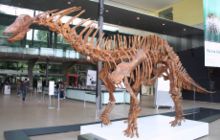
| |
| Amargasaurus skeleton cast in the Melbourne Museum foyer. | |
| Scientific classification | |
| Domain: | Eukaryota |
| Kingdom: | Animalia |
| Phylum: | Chordata |
| Clade: | Dinosauria |
| Clade: | Saurischia |
| Clade: | †Sauropodomorpha |
| Clade: | †Sauropoda |
| Superfamily: | †Diplodocoidea |
| Family: | †Dicraeosauridae |
| Genus: | †Amargasaurus Salgado & Bonaparte, 1991 |
| Species: | †A. cazaui
|
| Binomial name | |
| †Amargasaurus cazaui Bonaparte , 1991 | |
Amargasaurus (
Amargasaurus was discovered in
Description

Amargasaurus was small for a sauropod, measuring 9 to 13 meters (30 to 43 feet) in length and weighing approximately 2.6–4 metric tons (2.9–4.4 short tons).

The most striking features of the skeleton were the extremely tall, upwardly projecting
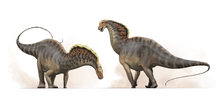
Only the rear part of the skull is preserved. It likely showed a horselike, broad snout equipped with pencil-like teeth, as seen in related sauropods for which more complete skulls are known.[10] As in other dicraeosaurids, the external naris (nostril opening) was situated in the posterior half of the skull, diagonally above the orbit (eye opening), which was proportionally large.[7][11] As in most other dinosaurs, the skull featured three additional openings (fenestrae). The infratemporal fenestra, located below the orbit, was long and narrow.[11] Behind the orbit was the supratemporal fenestra, which in dicraeosaurids was uniquely small and can be seen when the skull is viewed from the side. This contrasts with other diapsid reptiles, where these openings were directed upward, thus being visible only in top view.[2] The antorbital fenestra would have been located in front of the eye opening, although this region is not preserved. An unusual feature were small openings seen on the backside of the skull, the so-called parietal openings or fontanelles. In other tetrapods, these openings are usually seen only in juveniles and would close as the individual grows.[12][13] Skull features shared with Dicraeosaurus but absent in most other sauropods included the fused frontal bones and the notably long basipterygoid processes, bony extensions connecting the braincase with the palate.[11]
Discovery
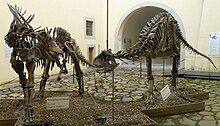
The only known skeleton (specimen number

The skeleton is reasonably complete and includes a partial skull. Sauropod skull bones are rarely found,
The first,
Classification
Amargasaurus is classified as a member of the Dicraeosauridae, a family ranked clade within the Diplodocoidea. Currently, this clade consists of nine species belonging to eight genera. These include Lingwulong shenqi from the Early or Middle Jurassic of China and four species from the Late Jurassic: Brachytrachelopan mesai from Argentina; Suuwassea emilieae from the Morrison Formation of the United States; and Dicraeosaurus hansemanni and Dicraeosaurus sattleri from the Tendaguru beds of Tanzania. Amargasaurus was the first dicraeosaurid known from the Cretaceous,[2] although additional dicraeosaurids from the Lower Cretaceous have been described more recently, including Pilmatueia faundezi, Amargatitanis macni, and Bajadasaurus pronuspinax, which are all from Argentina.[19][20][21][8] An unnamed specimen from Brazil indicates that this group persisted at least until the end of the Early Cretaceous.[2] Most analyses find Dicraeosaurus and Brachytrachelopan to be more closely related to each other than to Amargasaurus.[6][22][23] Suuwassea is generally recovered as the most basal member of the family.[20]: 17 [8][19] A 2015 analysis by Tschopp and colleagues came to the preliminary result that two poorly known genera from the Morrison Formation, Dyslocosaurus polyonychius and Dystrophaeus viaemalae, might be additional members of the Dicraeosauridae.[21]: 202, 214
Together with the Diplodocidae and the Rebbachisauridae, the Dicraeosauridae is nested inside the Diplodocoidea. All members of the Diplodocoidea are characterized by their box-shaped snout and narrow teeth restricted to the foremost portion of the jaws. Both the Dicraeosauridae and the Diplodocidae are characterized by bifurcated neural spines of the cervical and dorsal vertebra. In the Dicraeosauridae, the bifurcated neural spines were strongly elongated, a trend reaching its extreme in Amargasaurus.[10]
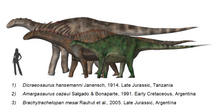
The following cladogram by Gallina and colleagues (2019)[8] shows the presumed relationships between members of the Dicraeosauridae:
Paleobiology
Vertebral spines

Both the function and the appearance in life of the extremely elongated and bifurcated vertebral spines remain elusive.
Jack Bailey, in 1997, argued that the spines resembled those of sail-bearing pelycosaurs like Dimetrodon. According to this author, Amargasaurus might also have possessed such a sail, which might have been used for display. Unlike those of pelycosaurs, the neural spines of Amargasaurus were bifurcated, forming a double row along the neck and back. As the space between both rows was merely 3 to 7 cm (1.2 to 2.8 inches), the existence of two parallel sails seems unlikely. Instead, Bailey suggested the spines represented a scaffold which was completely enveloped by a single skin. Neural spines from the penultimate dorsal vertebra to the foremost tail vertebrae also were strongly elongated, but different in structure, forming a single row of paddle-shaped projections. According to Bailey, these projections resembled those of modern humped ungulates such as the bison, indicating the presence of a fleshy hump above the hips. Bailey suggested similar humps for other dinosaurs with strongly elongated neural spines, such as Spinosaurus and Ouranosaurus.[9]
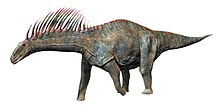
Daniela Schwarz and colleagues, in 2007, concluded that the bifurcated neural spines of diplodocids and dicraeosaurids enclosed an
In 2022, a detailed study by Ignacio A. Cerda and colleagues analyzing the structure, morphology, and microanatomy of the vertebral spines of Amargasaurus and an indeterminate dicraeosaurid (also from the La Amarga Formation) suggested that the spines were not covered in a keratinous sheath as previously believed. Osteohistology of the spines suggests that they were likely, if not exclusively, covered in a sail of skin. The spines are also highly vascularized and bear cyclical growth marks, adding credence to this theory.[27]
Senses and posture

Paulina Carabajal and colleagues, in 2014,
The first skeletal reconstructions show the skull in a near-horizontal posture. Salgado, in 1999, argued that such a posture would have been anatomically impossible due to the elongated neural spines of the neck vertebrae. Instead, he envisaged the head in a nearly vertical orientation.[12] The habitual orientation of the head is usually reflected by the orientation of the semicircular canals of the inner ear, which housed the sense of balance (vestibular system). Using their three-dimensional model of the inner ear, Carabajal and colleagues suggested that the snout faced downwards at an angle of roughly 65° relative to the horizontal.[28] A similar value has recently been proposed for the related Diplodocus.[23] The neutral posture of the neck can be approximated based on how the cervical vertebrae attached to each other. According to Carabajal and colleagues, the neck was gently sloping downwards, so that the snout would have rested 80 cm (2.6 ft) above the ground in neutral posture. In reality, neck posture would have varied according to the respective activities of the animals. Raising of the neck, e.g. for reaching an alert position, would have been constricted by the elongated neural spines, not permitting heights greater than 270 cm (8.9 ft).[28]
Locomotion

Amargasaurus was
Life history
In a 2021 study, Guillermo Windholz and Ignacio Cerda obtained
Paleoecology
Amargasaurus stems from
Other dinosaurs of the La Amarga Formation include an indeterminate
References
- S2CID 56028251.
- ^ ISBN 978-0-253-35289-7.
- ^ a b Upchurch, P.; Barrett, P. M.; Dodson, P. (2004). "Sauropoda". In Weishampel, D.B.; Dodson, P.; Osmolska, H. (eds.). The Dinosauria (2nd ed.). Berkeley: University of California Press. pp. 259–322.
- OCLC 985402380.
- ^ .
- ^ S2CID 4385136.
- ^ a b c d e f g h i j k l Salgado, L.; Bonaparte, J. F. (1991). "Un nuevo sauropodo Dicraeosauridae, Amargasaurus cazaui gen. et sp. nov., de la Formacion La Amarga, Neocomiano de la Provincia del Neuquén, Argentina". Ameghiniana (in Spanish). 28 (3–4): 333–346.
- ^ PMID 30718633.
- ^ S2CID 130861276.
- ^ ISBN 978-0-520-24623-2.
- ^ a b c d Salgado, L.; Calvo, J. O. (1992). "Cranial osteology of Amargasaurus cazaui Salgado and Bonaparte (Sauropoda, Dicraeosauridae) from the Neocomian of Patagonia". Ameghiniana. 29 (4): 337–346.
- ^ a b c Salgado, L. (1999). "The macroevolution of the Diplodocimorpha (Dinosauria; Sauropoda): A developmental model". Ameghiniana. 36 (2): 203–216.
- ^ ISBN 978-0-253-34542-4.
- ^ Bonaparte, J.F. (1981). "Jurassic and Cretaceous terrestrial vertebrates of South America". National Geographic Society Research Reports, 1975 Projects: 115–125.
- S2CID 132580445. Archived from the original(PDF) on July 21, 2010. Retrieved July 25, 2015.
- ^ .
- PMID 20179896.
- ISBN 978-0-375-82419-7.
- ^ PMID 30042444.
- ^ ISSN 1096-3642.
- ^ PMID 25870766.
- S2CID 17873254.
- ^ PMID 18030355.
- ^ Paul, G. S. (1994). "Dinosaur art & restoration notes: Dicraeosaurs" (PDF). The Dinosaur Report. 8. Archived (PDF) from the original on March 16, 2021. Retrieved February 22, 2019.
- ^ a b Schwarz, D.; Frey, E.; Meyer, C. A. (2007). "Pneumaticity and soft-tissue reconstructions in the neck of diplodocid and dicraeosaurid sauropods" (PDF). Acta Palaeontologica Polonica. 52 (1). Archived (PDF) from the original on November 3, 2016. Retrieved July 27, 2015.
- ^ ISBN 978-1-4214-2029-5.
- S2CID 247677750.
- ^ S2CID 85748606.
- ^ Mazzetta, G.V.; Farina, R.A. (1999). "Estimacion de la capacidad atlética de Amargasaurus cazaui Salgado y Bonaparte, 1991, y Carnotaurus sastrei Bonaparte, 1985 (Saurischia, Sauropoda-Theropoda)". Ameghiniana (in Spanish). 36 (1): 105–106.
- ISSN 0195-6671.
- ISSN 0195-6671.
- ^ .
- ^ Ulansky, R. E. (2014). "Dinosaurs classification. Basal Thyreophora & Stegosauria" (PDF). Dinologia: 1–8. Archived (PDF) from the original on December 22, 2019. Retrieved August 3, 2015.
